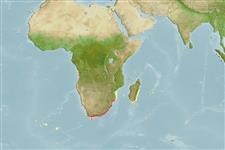>
Eupercaria/misc (Various families in series Eupercaria) >
Sparidae (Porgies)
Etymology: Rhabdosargus: Greek, rhabdos = stick + Latin, sargus = sargus (1591) (Ref. 45335).
More on author: Steindachner.
Environment: milieu / climate zone / depth range / distribution range
Ecologia
marinhas; estuarina demersal; oceanódromo (Ref. 51243). Subtropical
Southeast Atlantic: South Africa, from the Cape to Natal.
Comprimento de primeira maturação / Tamanho / Peso / Idade
Maturity: Lm 19.0 range ? - ? cm
Max length : 40.0 cm TL macho/indeterminado; (Ref. 3507); common length : 15.0 cm TL macho/indeterminado; (Ref. 3198)
Descrição suscinta
Chaves de identificação | Morfologia | Morfometria
Espinhos dorsais (total) : 11; Raios dorsais (total) : 12 - 13; Espinhos anais: 3; Raios anais : 10 - 11. Silvery with golden midlateral band from head to caudal peduncle (Ref. 3198).
Inhabits estuaries and shallow waters over sand and between rocks. Feeds mainly on small bivalves, shrimps and crabs (Ref. 3670). Flesh excellent (Ref. 3198).
Ciclo de vida ou comportamento de acasalamento
Maturities | Reprodução | Spawnings | Egg(s) | Fecundities | Larvas
Smith, J.L.B. and M.M. Smith, 1986. Sparidae. p. 580-594. In M.M. Smith and P.C. Heemstra (eds.) Smiths' sea fishes. Springer-Verlag, Berlin. (Ref. 3198)
Status na Lista Vermelha da UICN (Ref. 130435)
Ameaça para os humanos
Harmless
Uso pelos humanos
Pescarias: pouco comercial; peixe esportivo: sim; isca: usually
Ferramentas
Relatórios especiais
Baixar XML
Fontes da internet
Estimates based on models
Preferred temperature (Ref.
123201): 17.5 - 27.6, mean 25.6 °C (based on 237 cells).
Índice de diversidade filogenética (Ref.
82804): PD
50 = 0.5156 [Uniqueness, from 0.5 = low to 2.0 = high].
Bayesian length-weight: a=0.01738 (0.01067 - 0.02829), b=3.06 (2.92 - 3.20), in cm total length, based on LWR estimates for this species & (Sub)family-body (Ref.
93245).
Nível Trófico (Ref.
69278): 2.8 ±0.2 se; based on diet studies.
Resiliência (Ref.
120179): médio(a), tempo mínimo de duplicação da população 1,4 - 4,4 anos (Preliminary K or Fecundity.).
Fishing Vulnerability (Ref.
59153): Low to moderate vulnerability (30 of 100).
Nutrients (Ref.
124155): Calcium = 91.6 [48.0, 177.6] mg/100g; Iron = 1.13 [0.65, 2.08] mg/100g; Protein = 19.5 [18.6, 20.5] %; Omega3 = 0.379 [0.257, 0.596] g/100g; Selenium = 23.5 [11.8, 42.1] μg/100g; VitaminA = 11.6 [3.9, 29.5] μg/100g; Zinc = 1.07 [0.75, 1.50] mg/100g (wet weight);
